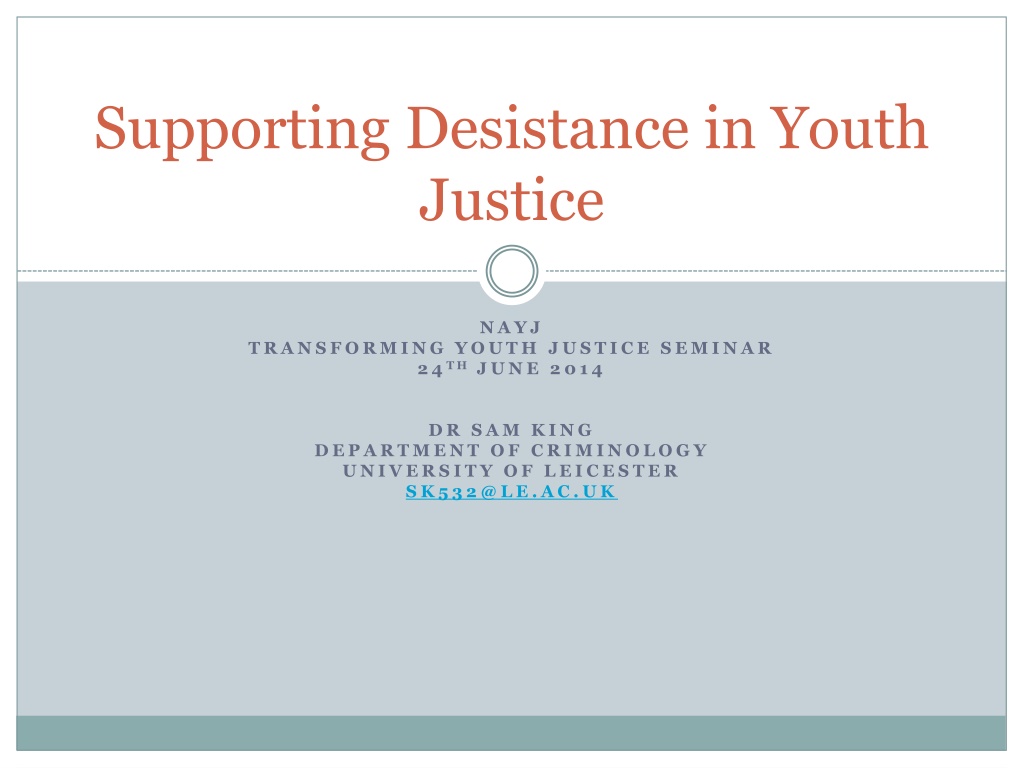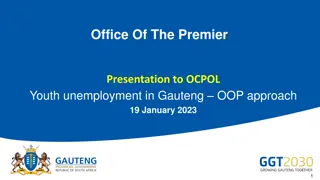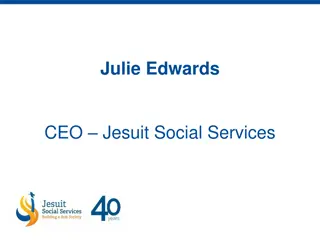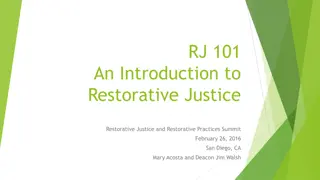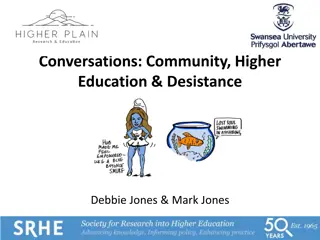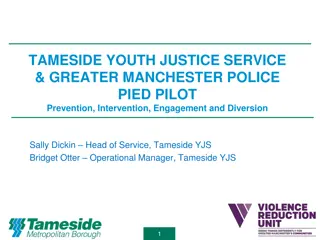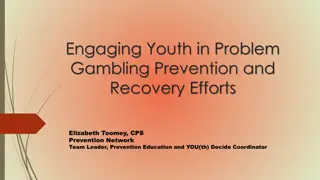Understanding Desistance in Youth Justice
Desistance in youth justice refers to the process of behavior change over time, involving factors such as formal compliance, social bonds, identity, agency, and belonging. It is essential to support young individuals in their journey towards desistance to reduce reoffending rates effectively.
Download Presentation

Please find below an Image/Link to download the presentation.
The content on the website is provided AS IS for your information and personal use only. It may not be sold, licensed, or shared on other websites without obtaining consent from the author. Download presentation by click this link. If you encounter any issues during the download, it is possible that the publisher has removed the file from their server.
E N D
Presentation Transcript
Supporting Desistance in Youth Justice N A Y J T R A N S F O R M I N G Y O U T H J U S T I C E S E M I N A R 2 4T HJ U N E 2 0 1 4 D R S A M K I N G D E P A R T M E N T O F C R I M I N O L O G Y U N I V E R S I T Y O F L E I C E S T E R S K 5 3 2 @ L E . A C . U K
What is desistance? Behaviour Formal compliance Short-term Primary Age/maturity Social bonds Identity Substantive compliance Long-term Secondary Situated agency Narrative/identity Belonging Substantive compliance Long-term Tertiary Based on Robinson and McNeill, 2008; McNeill, 2014
Key definitional features of desistance Process, not an event, lapse and relapse are common It is naturally occurring , but assisted desistance is possible Different forms of desistance (primary, secondary, tertiary) Interactive effects of individual (human capital, agency), society (social bonds, social capital), community (identity, belonging) and CJS (de- labelling)
Why desistance matters for young people Dynamics of change Avoid labels, categories, classifications Personal/individual change Lapse/relapse Assisted desistance Practices for long-term reductions in reoffending Support when people are ready to change Encouragement when people are not yet ready What outcomes matter Processes Joined up Holistic Based on Healy, 2010; King, 2013a
Why desistance matters for young people General population 11-15 yrs 3,668,302 Commencing community sentence 16-20 yrs 4,005,542 Probation caseload 21-24 yrs 3,483,414 Of those sentenced to custody 9,691,459 Are, or about to be, fathers Sources: T2A, 2012; ONS, 2013
Key messages about why desistance matters for young people Youth, adolescence, young adulthood, adulthood What do these labels actually mean? The way we respond to people now impacts on processes of desistance Little wonder lapse and relapse occur? It is possible to support desistance Aged out or assisted out?
The process of desistance Relapse Offending Triggers e.g. longer sentence, harm caused, external influence etc. Obstacles (breakdown of bonds, temptation, necessity) Maintenance Open to change Human and social capital developed Desistance Perceives lifestyle and situational context differently Enhanced social bonding, change in routines, change in peers Opportunities to change taking action Adapted from Shapland and Bottoms, 2011
The evidence base People choose to desist, but certain practices (e.g. arts, learning, relationships, routines) can initiate the choice (needs to be opportunities) Opportunities come in many forms (education, employment, housing, relationships) For some this occurs naturally (ageing), for others requires the right balance of maturity and social bonds Recognition of social bonds changes as individuals mature
Maturity Maturity is a core, developmental concept which addresses the processes through which a young person achieves the status of adulthood. These developmental processes include the interactions between physical, intellectual, neurological, emotional and social development. Although physical and intellectual development is usually completed during adolescence, for some people emotional and social maturation can continue into the early to mid-twenties. Young adults often differ from each other because of their variable maturity and these differences often show themselves in the ways in which individuals manage the multiple transitions which are associated with the journey to adulthood (University of Birmingham, BCT and T2A, 2013: 2, emphasis added).
Maturity Responsibility Independence, self-reliance, personal identity Temperance Evaluate consequences, limit impulsivity, control aggressive responses Perspective Consider views of others, understand wider context within which decisions are made Source Prior et al, 2011
Maturity and desistance Challenge of making personal transitions Transition through childhood, adolescence and into adulthood Transition towards and subsequent maintenance of desistance Challenge of making transition from youth to adult services 4% young people report good transition from CAMHS to AMHS Loss of support and inconsistency in taking account of maturity Challenge of developing social bonds Education, training, employment Community, sense of belonging Sources: Howard League, 2005; Revolving Doors Agency, 2013; Young Minds, 2013
Key messages about maturity and desistance Desistance depends upon particular interaction of individual and social factors Can be initiated by life events or prompting by another individual Involves development of strong personal identity and understanding of social context through human agency and maturity But, requires social context with opportunities, sense of belonging and a process of certification
Impeding or assisting desistance Deprivation of liberty Deprivation of relationships Causing harm or reducing opportunities Deprivation of identity Limiting reflexive thinking Enhancing liberty Encouraging relationships Providing opportunities or goods Enhancing identity Allowing room for and encouraging reflexive thinking
What should youth justice look like? Community centres offering one-stop shops are known to work well with women and young people who have offended Is there scope for developing workshops to encourage human agency and maturity? Are there alternative ways of assessing human agency and maturity? Is it possible to provide alternative ways of working with young people who are not ready to desist?
References Healy, D. (2010) The Dynamics of Desistance: Charting Pathways Through Change. Cullompton: Willan. The Howard League (2005) Young, neglected and back: young men in prison. Research briefing 2. London: The Howard League. King, S. (2013a) Assisted Desistance: Experiences of Probation Probation Journal, 60(2): 136-151. King, S. (2013b) Desistance Transitions and the Impact of Probation. Abingdon: Routledge. McNeill, F. (2014) Three aspects of desistance, blog-post based on a short paper prepared for a University of Sheffield Centre for Criminological Research Knowledge Exchange Seminar at the British Academy in London on 15th May 2014, online at http://blogs.iriss.org.uk/discoveringdesistance/2014/05/23/three-aspects-of-desistance/ ONS (2013) Population Estimates by Age and Sex, online at http://ons.gov.uk/ons/taxonomy/search/index.html?nscl=Population+Estimates+by+Age+and+Sex&nscl- orig=Population+Estimates+by+Age+and+Sex&content-type=Summary&content- type=Video&sortDirection=DESCENDING&sortBy=pubdate Prior, D., Farrow, K., Hughes, N., Kelly, G., Manders, G., White, S. and Wilkinson, B. (2011) Maturity, young adults and criminal justice: a literature review. University of Birmingham: IASS. Revolving Doors Agency (2013) First Generation: One Year On, online at http://www.t2a.org.uk/publications/#all Robinson, G. and McNeill, F. (2008) Exploring the dynamics of compliance with community penalties Theoretical Criminology, 12(4): 431-449. Shapland, J. and Bottoms, A. (2011) Reflections on social values, offending and desistance among young adult recidivists, Punishment and Society, 13(3): 256-291. T2A (2012) Pathways from Crime, online at http://www.t2a.org.uk/publications/#all University of Birmingham, BCT and T2A (2013) Taking Account of Maturity: A Guide for Probation Practitioners, online at http://www.t2a.org.uk/publications/#all Young Minds (2013) Same Old the experiences of young offenders with mental health needs, online at http://www.t2a.org.uk/publications/#all
